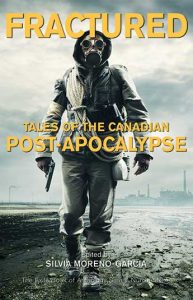Silvia Moreno-Garcia (editor), 345 pgs, Exile Editions, ExileEditions.com, $19.95
If you’re anything like me, you hear the words “Canadian Post-Apocalypse” and you instantly picture Gloria Gaynor singing “I Will Survive” while doing the fox-trot with a moose atop a CN Tower-sized mound of human skulls gushing boiling hot maple syrup from their eye sockets… no? It’s just me? Ahem, all righty then. Let’s carry on.
At the core of any good post-apocalyptic tale is the notion of survival. The stories in Fractured are not all bleakly dystopian, because as editor Silvia Moreno-Garcia points out in the introduction, “There is something hopeful about the post-apocalypse precisely because it is post.” As singer/songwriter Daniel Johnston says, “Where there’s life, there’s hope.” The Apocalypse has come and gone, and somehow our protagonists have survived.
The stories in this collection range far and wide across an imagined Canada beset with horrors: floods and cannibals and aliens and ghosts (although not all in the same story— how cool would that be?). In the pages of Fracture, Jean-Louis Trudel takes us to a laser battle above the sunken streets of a mostly-submerged Quebec in “St. Macaire’s Dome”. Michael Matheson paints a visceral picture of Western Horror in “Jenny of The Long Gauge.” Two trans people in love navigate their escape from a burnt-out cityscape in Morgan M. Page’s “City Noise.”
In these stories and in many other post-apocalyptic tales, the central question remains: how do we live? How do we as a species reign in our destructive impulses to build communities in which we can not only survive, but thrive? People come together in a crisis. Hopefully it won’t take scenarios as dire as those laid out in Fracture to make us realize that when it comes to this thing called life, we’re all in this together. (AG Pasquella)

